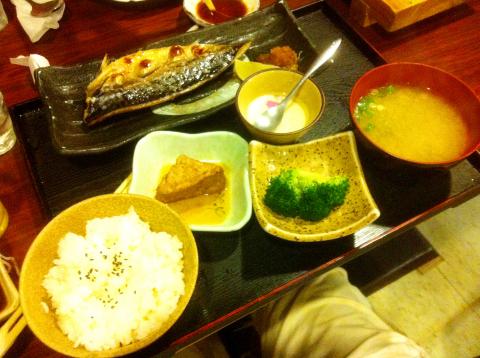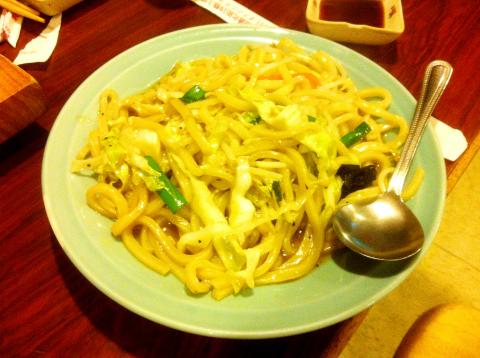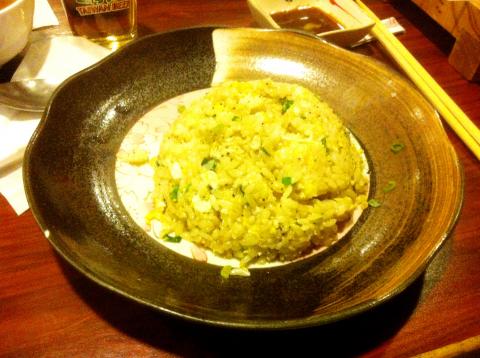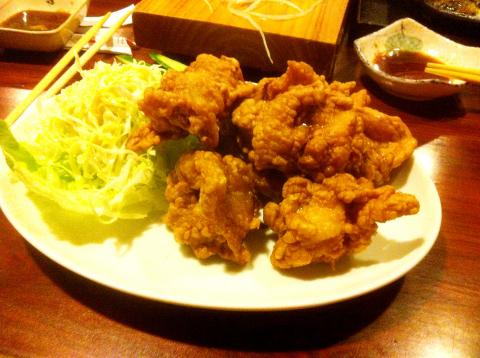A decent Japanese meal in Taipei doesn’t have to be chichi and expensive. Nippon Shokudo, hidden away in an alley within the Tonghua Street Night Market (通化街夜市), has long been a favorite among students and bloggers, as the food is simple, reasonably priced and soul-satisfying good.
The source of the restaurant’s mojo is Japanese owner and chef Ishii Mitsuharu (石井光晴), who is easy to spot in his white apron and headband. A short and stocky middle-aged man with closely cropped grey hair, Ishii constantly shuffles in and out of the kitchen, stirring, slicing and chopping all the while. When the restaurant isn’t busy, you might catch him standing by the sushi bar, humming along to Japanese oldies performed on NHK blaring on a flat-screen in the corner of the restaurant.
Nippon Shokudo feels like the equivalent of a casual family restaurant in Japan, with a menu to match. Staple dishes include rice bowl meals such as ten-don (天丼, in Mandarin, “tiandong”, NT$110), the tonkastsu (fried breaded pork cutlet) bowl (豬肉蓋飯, NT$150) and Japanese style curry (日式咖哩飯, NT$110).

Photo: David Chen, Taipei Times
One of the restaurant’s most popular dishes, however, is more of a night market standard than a classic Japanese dish. The fried chicken chunks, served with rice and a small salad of shredded cabbage in a set menu (酥炸雞塊定食, NT$180), have garnered plenty of praise from bloggers for having the perfect combination of tenderness on the inside and crispness on the outside.
When I tried the dish, it fell a bit short on the latter — the batter coating lost its crunch quickly and got a little soggy. But the meat was indeed tender and not as greasy as what one finds at the run-of-the mill cafeteria or night market stand. But I liked it enough and would order it again.
Having read favorable online reviews of the stewed pig intestines set meal (NT$160, 燉煮豬腸定食), another popular choice, one of my dining companions ordered the dish and was glad she did. I had a taste and found the broth to be hearty and slightly spicy, flavored by the chunks of radish and the pungent flavor of the intestines.

Photo: David Chen, Taipei Times
Those less adventurous will find the barbecue set meal (燒肉定食, NT$260, with a choice of beef or pork) to be a fail-safe choice. The beef used by the restaurant isn’t of the highest quality, but an excellent teriyaki wine sauce, which had light sweet and sour notes, more than makes up for this shortcoming. The grilled mackerel set meal (鯖魚燒烤定食, NT$170) is also reliably good.
One minor quibble with the set meals: While the main dishes hit the spot, the side dishes are neglected as afterthoughts — the steamed egg is watery and tasteless, and the vegetables, usually a small portion of string beans or chopped greens, are also lacking in flavor.
Nippon Shokudo’s interior looks dated and run-down, as if it had been decades since they’ve renovated, but the space has a homey charm and is well-kept and tidy (I’ve never seen a broken-tiled floor that was so spotlessly clean). One wall is adorned with Japan-themed lanterns and fading posters, as well as menu items written on colored paper in Japanese, presumably for expats and homesick tourists. Atop the sushi bar sit stacks of plates and random knack-knacks, which somehow look both cluttered and organized at the same time.

Photo: David Chen, Taipei Times
But this won’t distract you from the standard sushi and sashimi platters, which cost between NT$150 to NT$600. The restaurant is stocked with beer and sake — tall bottles of Taiwan Beer are NT$80, Kirin NT$120, sake NT$120 per serving. Patrons are also welcome to bring their own, with corkage fees NT$350 for wine and NT$500 for whiskey.

Photo: David Chen, Taipei Times

Photo: David Chen, Taipei Times

In the March 9 edition of the Taipei Times a piece by Ninon Godefroy ran with the headine “The quiet, gentle rhythm of Taiwan.” It started with the line “Taiwan is a small, humble place. There is no Eiffel Tower, no pyramids — no singular attraction that draws the world’s attention.” I laughed out loud at that. This was out of no disrespect for the author or the piece, which made some interesting analogies and good points about how both Din Tai Fung’s and Taiwan Semiconductor Manufacturing Co’s (TSMC, 台積電) meticulous attention to detail and quality are not quite up to

April 21 to April 27 Hsieh Er’s (謝娥) political fortunes were rising fast after she got out of jail and joined the Chinese Nationalist Party (KMT) in December 1945. Not only did she hold key positions in various committees, she was elected the only woman on the Taipei City Council and headed to Nanjing in 1946 as the sole Taiwanese female representative to the National Constituent Assembly. With the support of first lady Soong May-ling (宋美齡), she started the Taipei Women’s Association and Taiwan Provincial Women’s Association, where she

Chinese Nationalist Party (KMT) Chairman Eric Chu (朱立倫) hatched a bold plan to charge forward and seize the initiative when he held a protest in front of the Taipei City Prosecutors’ Office. Though risky, because illegal, its success would help tackle at least six problems facing both himself and the KMT. What he did not see coming was Taipei Mayor Chiang Wan-an (將萬安) tripping him up out of the gate. In spite of Chu being the most consequential and successful KMT chairman since the early 2010s — arguably saving the party from financial ruin and restoring its electoral viability —

It is one of the more remarkable facts of Taiwan history that it was never occupied or claimed by any of the numerous kingdoms of southern China — Han or otherwise — that lay just across the water from it. None of their brilliant ministers ever discovered that Taiwan was a “core interest” of the state whose annexation was “inevitable.” As Paul Kua notes in an excellent monograph laying out how the Portuguese gave Taiwan the name “Formosa,” the first Europeans to express an interest in occupying Taiwan were the Spanish. Tonio Andrade in his seminal work, How Taiwan Became Chinese,